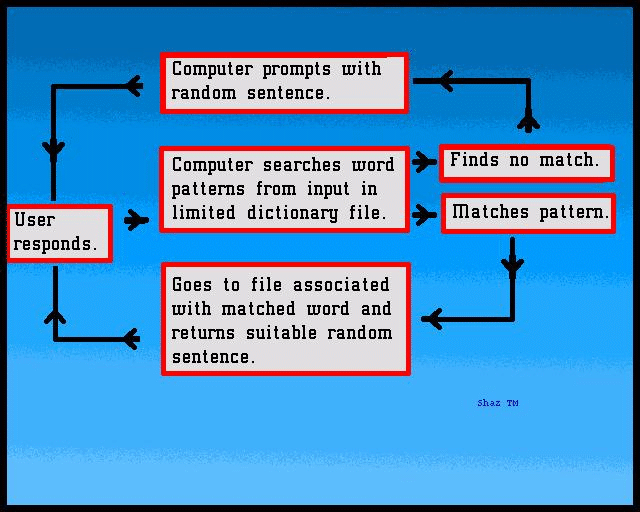


Next: Into the Future
Up: Artificial Intelligence -- Talking
Previous: In The Beginning
One of the things that sets the human apart from other species in the
animal world, is his ability to communicate. Without the tool of language
the development of our species to the stage where we can begin to
comprehend the science beyond our existence, would, in all liklihood,
be beyond our limitations.
The key areas of communication are:
* To give information
* For that information to be understood
* For indication to be given that the communicated information has been
understood.
The ``Natural Language Problem'' is the name given to that area of AI
development which deals exclusively with making machines interact on the
level of conversation with their human users.
The machine itself has the language of binary code. Strings of 0's and 1's,
representing a switch in an on or off state,
will enable the computer to perform logical calculations and
operations. By teaching the computer to recognise a set pattern of these
binary strings as representing some highly specific instruction and matching
these strings to key words or symbols in a programming language, a
computer programmer can use a defined set of instructions to build more
complex problems for the machine to deal with.
For the mere mortal, it might be nice to be able to talk to a machine as
one might to an assistant or employee, to deliver instructions in ones
native language, without the bother of learning one or maybe several
intricate programming languages and then utilising them, or worse still
sitting down and individually setting several billion switches to their
appropriate binary settings. Here, then, is the task of the AI programmer
dealing with the Natural Language Problem;
to teach a machine to learn the intricacies of human language rather than
vice versa.
The machine may be taught to recognise nouns, verbs, conjunctions, an so
on. To give meaning to each word, or to search only for keywords, and
discarding all others, to follow the instructions it interprets. Different
machines may be taught to recognise written instructions, or to match
oral patterns to a memory of pre-designated commands.
It can take years for a human to master just one language, and longer to
teach a computer to do the same. How long then might it take to teach a
computer to recognise so many languages, each with its own dialect, that
any individual, the whole world over, could sit before it and instruct it
with as much ease and simplicity as one might with a fellow human?
An example of a primitive ``talking'' machine, designed in 1966 by
Weizenbaum and Colby,
is Eliza, the algorithm for which has been used and abused by many
people over the ensuing decades. An example of a much degraded version
of the program is attached in Appendix A.
For the time being let us examine the algorithm to understand how, based
loosely on human intuition, a machine can be taught to think and talk.
As can be seen from the flowchart below, this program works
on quite a simple algorithm. The conversation may not be the most
stimulating the user might hope, but it will be relatively
coherent. The greater the expansion and development of library
information afforded to the machine the more realistic the program
will seem.
 A machine can also be taught to recognise sentence and
grammatical structures. By matching more than one aspect of the
sentence, for example all the nouns and the verbs joining them,
and working from a greatly expanded library, or even a limited
library with a different algorithm to construct sentences from
several clauses, conversation may become more developed.
A machine can also be taught to recognise sentence and
grammatical structures. By matching more than one aspect of the
sentence, for example all the nouns and the verbs joining them,
and working from a greatly expanded library, or even a limited
library with a different algorithm to construct sentences from
several clauses, conversation may become more developed.
While this program is used mainly for entertainment, with appropriate
adjustment it could be used as a reference tool, working off vast
encyclopediae of information.
Seeing this simple ``talking'' program, it is apparent how the concept
could be applied to other areas. By instructing a computer to perform
a task and asking it to mirror the information it thinks it has
been given for verification before proceeding, processes can be carried
out without the necessity of the human learning the language of the
machine, sometimes a highly arduous task.



Next: Into the Future
Up: Artificial Intelligence -- Talking
Previous: In The Beginning
Sharon Murphy
Wed Mar 15 10:45:48 GMT 1995
 A machine can also be taught to recognise sentence and
grammatical structures. By matching more than one aspect of the
sentence, for example all the nouns and the verbs joining them,
and working from a greatly expanded library, or even a limited
library with a different algorithm to construct sentences from
several clauses, conversation may become more developed.
A machine can also be taught to recognise sentence and
grammatical structures. By matching more than one aspect of the
sentence, for example all the nouns and the verbs joining them,
and working from a greatly expanded library, or even a limited
library with a different algorithm to construct sentences from
several clauses, conversation may become more developed.